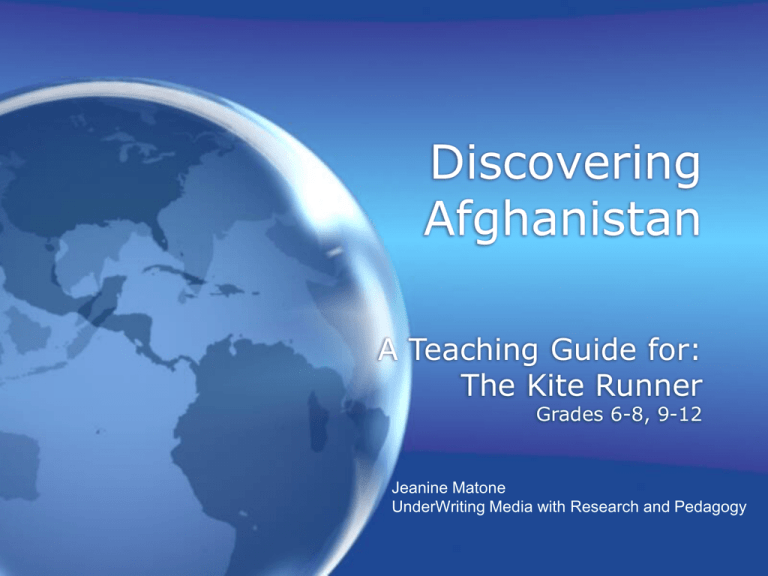Discovering Afghanistan
advertisement

Discovering Afghanistan A Teaching Guide for: The Kite Runner Grades 6-8, 9-12 Jeanine Matone UnderWriting Media with Research and Pedagogy Curriculum Standards NJCCS Standard 6.2 World History/Global Studies 6.2.A Civics, Government & Human Rights • How have economic, political, and cultural decisions promoted or prevented the growth of personal freedom, individual responsibility, equality, and respect for human dignity? 6.2.B Geography, People and the Environment • How do physical, geography, human geography, and the human environment interact to influence or determine the development of cultures, societies, and nations? 6.2.D History, Culture, and Perspective • How can the study of multiple perspectives, belief systems, and cultures provide a context for understanding and challenging public actions in a diverse and interdependent world? Getting Started Prior to showing the film, build background information….. • Map Skills • Historical Time Line • Ethnic Groups in Afghanistan – Pashtuns – Hazaras – Tajiks Ethnic Groups of Afghanistan Movie Summary and Trailer Based on the book by Khaled Hosseini Film by Marc Forster In the 70's in Afghanistan, the Pushtun boy Amir and the Hazara boy Hassan, who is his loyal friend and son of their Hazara servant Ali, are raised together in Amir's father house, playing and kitting on the streets of a peaceful Kabul. Amir feels that his wise and good father Baba blames him for the death of his mother in the delivery, and also that his father loves and prefers Hassan to him. In return, Amir feels a great respect for his father's best friend Rahim Khan, who supports his intention to become a writer. After Amir winning a competition of kitting, Hassan runs to bring a kite to Amir, but he is beaten and raped by the brutal Assef in an empty street to protect Amir's kite; the coward Amir witness the assault but does not help the loyal Hassam. On the day after his birthday party, Amir hides his new watch in Hassan's bed to frame the boy as a thief and force his father to fire Ali, releasing his conscience from recalling his cowardice and betrayal. In 1979, the Russians invade Afghanistan and Baba and Amir escape to Pakistan. In 1988, they have a simple life in Fremont, California, when Amir graduates in a public college for the pride and joy of Baba. Later Amir meets his countrywoman Soraya and they get married. In 2000, after the death of Baba, Amir is a famous novelist and receives a phone call from the terminal Rahim Khan, who discloses secrets about his family, forcing Amir to return to Peshawar, in Pakistan, in a journey of redemption. When the Taliban Ruled Afghanistan When the Taliban Ruled Afghanistan. Discovery Education. 2004.Discovery Education. 16 October 2009<http://streaming.discoveryeducation.com/> QuickTime™ and a Sorenson Video 3 decompressor are needed to see this picture. (5:38 min) Following the withdrawal of the Soviet Union from Afghanistan in 1989, civil war erupted among rival groups seeking power. The Taliban, seized power and brought order to most of Afghanistan. Their stated goal was to create a strict Islamic state that was based on Afghanistan customs and the tenets of Islam. As a result, life changed dramatically for the people, especially women, as all traces of western influence were removed. A Matter of Human Rights Taliban’s War Against the Women of Afghanistan • Ban on women’s work outside the home • Complete ban on women's activity outside the home unless accompanied by a mahram (close male relative such as a father, brother or husband). • Ban on women studying at schools, universities or any other educational institution. • Females must wear a long veil (burqa) which covers them head to toe Links for further reading: U.S. Department of State, Bureau of Democracy, Human Rights and Labor http://www.state.gov/g/drl/rls/6185.htm Revolutionary Association of the Women of Afghanistan (RAWA) Some of the Restrictions Imposed by Taliban on Women in Afghanistan http://www.rawa.org/rules.htm Challenges Facing the Woman of Afghanistan QuickTime™ and a Sorenson Video 3 decompressor are needed to see this picture. Taliban: Abuses of an Oppressive Regime In the scene where Amir goes back to Afghanistan and reaches Ghazi Stadium, he witnesses the Taliban’s public executions on the soccer field. Questions for Thought: What are human rights? Who has human rights? Whose responsibility is it to bring about solutions to human rights issues? Individuals? Organizations? Governments? All of the above? None of the above? In the Kite Runner, we meet Amir and Hassan, two boys who share a deep and incredible friendship. Yet from the beginning it is clear that all is not equal. “For you, a thousand times over.” Questions for Thought: How were the two boys lives different? Are there circumstances or influences that can keep people from being true friends? Kite Running QuickTime™ and a YUV420 codec decompressor are needed to see this picture. Work Cited The Kite Runner Companion Curriculum http://www.amnestyusa.org/education/pdf/kiterunnerhigh.pdf The Kite Runner Movie - Official Site http://www.kiterunnermovie.com/ Afghanistan and the War on Terror http://www.pbs.org/newshour/indepth_coverage/asia/afghani stan/index.html Ethnic Groups of Afghanistan http://www.afghan-network.net/Ethnic-Groups/




